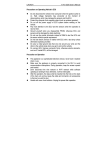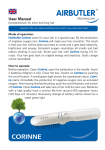Download Operating Instructions - H-Tec
Transcript
Operating Instructions J101 JuniorBasic J102 JuniorSet www.h-tec.com www.h-tec.com h-tec Wasserstoff-Energie-Systeme GmbH Hydrogen Energy Systems Lindenstrasse 48 a 23558 Luebeck GERMANY Phone: +49 (0) 451-49 89 5-0 Telefax: +49 (0) 451-49 89 5-15 e-mail: [email protected] 2 www.h-tec.com Contents 04 Your Duties as a Supervisor 04 Objective / Introduction 05 Intended Use 06 General Safety Precautions 08 Overview of JuniorBasic 09 Setting up 11 Experiments from the accompanying book 12 Maintenance 12 Troubleshooting 14 Material and Technical Data 3 www.h-tec.com Your Duties as a Supervisor Objective / Introduction These Operating Instructions are intended for the responsible supervisor. Read the Operating Instructions before using the equipment. Observe the instructions and keep them on hand. Pay particular attention to the General Safety Precautions (see Page 6). This product may be set up and operated only under the supervision of the person responsible. Objective / Introduction The predicted climate change combined with the worldwide increase in energy requirements and the declining resources of coal, oil and gas make the development of new energy sources one of the main tasks of the 21st century. Hydrogen technology is particularly important in this regard. With the help of fuel cells, electricity can be produced directly from hydrogen and oxygen. The only waste product is water. With the help of electricity, which is obtained from solar cells for example, the required hydrogen can in turn be produced directly from water by splitting into hydrogen and oxygen. The principle on which this is based is called electrolysis. Together, the two processes form the solar hydrogen cycle. All stages of the solar hydrogen cycle can be clearly explained with simple experiments using this working model. A simple principle, which works on both a small and a large scale, and in doing so conserves resources and unburdens the environment. It is therefore no wonder that all experts in fuel cell technology forecast excellent prospects for the future. The design, set-up and operation of the Junior Basic are explained in this 4 www.h-tec.com Intended Use manual. You will also find suggestions for using the equipment in tutorials. The team wishes you exciting experiments and an interesting insight into the future of energy supply h-tec Wasserstoff-Energie-Systeme GmbH Intended Use The equipment described in this manual allows the principles of PEM fuel cells (PEM = proton exchange membrane), PEM electrolysers and solar modules to be demonstrated, and appropriate measurements to be taken. The equipment has been developed for teaching and demonstration purposes only. Any other use is prohibited. WARNING! Distilled water is required to operate the JuniorBasic. The electrolyser splits this water into hydrogen and oxygen. In the fuel cell, hydrogen (H2) and oxygen (O2) react again. These gases can be dangerous if handled improperly. In order to avoid any risks you must follow the recommended safety precautions when using the equipment. h-tec cells are clearly color-coded according to their function. blue: electrolyser red: fuel cell 5 www.h-tec.com General Safety Precautions General Safety Precautions The system is intended for teaching and demonstration purposes in schools, universities, institutions and companies only. The units may only be set up and operated by a responsible supervisor. WARNING! Not suitable for children under 12 years! Read the Operating Instructions before setting up the fuel cell. Follow them during use and keep them readily available for reference. The equipment may only be used with the h-tec solar modules provided for the purpose (h-tec Solar Module Basic, Item No. A142), h-tec battery box (BatteryBox, Item No. A115) or h-tec plug-in power supplies (h-tec Power Supply, Item No. A145). Wear protective goggles. Equipment and gases must be used and stored out of the reach of small children. Plug-in power supplies can be dangerous - they are not toys! Disconnect the unit from the plug-in power supply and the solar module before cleaning with liquids. Unless instructed to the contrary by the manual, do not reverse or short-circuit the connecting terminals. The units must not be operated when empty. Always ensure that they contain sufficient water. Pay attention to the water level marks. Remove flammable gases, vapours or liquids from the area surrounding fuel cells and electrolysers. The catalytic materials involved may cause spontaneous ignition. Hydrogen and oxygen may escape from the units. Operate the units in well-ventilated rooms to ensure that the gases do not accumulate and form explosive mixtures. 6 General Safety Precautions www.h-tec.com The units may only be operated in display cases if adequate ventilation is guaranteed under all circumstances. The operator is responsible for ensuring this. Remove from the vicinity of the units anything that could ignite the hydrogen (e.g. open flame, materials that can become charged with static electricity, substances with a catalytic action). Remove from the vicinity of the units all substances that could spontaneously ignite in increased oxygen concentration. Do not smoke. Hoses, plugs and gas tanks are used for pressure compensation. They must not be fixed or secured with clamps, adhesive, etc. Only use the gas storage tanks associated with or supplied with the units. Never connect alternative gas storage tanks. The units may only be operated at room temperature and ambient pressure. Never apply an external voltage to the fuel cell. This may lead to damage. Explosive gas may also accumulate in the storage tanks. Minimum separation distances must be observed when using solar modules and artificial lights. These are: 30 cm between h-tec solar modules and the h-tec Videolight, and 50 cm in the case of the h-tec Spotlight. When using lights from other manufacturers, observe the minimum distance specified by them. WARNING! The surface of solar modules can get very hot during extended operation. Tell your students about any potential dangers and carefully supervise experimentation. h-tec accepts no responsibility for injuries or damage sustained in the event that these Safety Precautions are not followed. 7 www.h-tec.com Overview of JuniorBasic (J101) The JuniorBasic is a working model of the solar hydrogen cycle. The solar module generates electricity, which is used to break down the distilled water in the electrolyser into oxygen and hydrogen gas. The gases are collected in Electrolyser Gas storage tanks Fuel Cell Electric load Overview of JuniorBasic Solar module separate gas storage tanks. Then, in the fuel cell, the two gases react with one another to form water. This reaction generates electricity, which can be used to operate an electric load. The JuniorBasic system comprises: Baseplate Cap JuniorBasic (J101) 1x Basic experimental system comprising solar module, PEM electrolyser, hydrogen and oxygen storage tanks, PEM fuel cell and fan on a baseplate (Item No. J101) Accompanying book „Fuel Cell Technology for Classroom Instruction“ Commercially available distilled water (conductivity <2 µS/cm) To operate the system in poor lighting conditions: h-tec Videolight or Spotlight lamps or h-tec Junior PowerSupply Absorbent cloths The following will also be required: 8 www.h-tec.com Setting up 1. Before filling, check that the caps are fitted to the bottom connectors of the fuel cell. Marks 2. Fill both storage tanks with distilled water up to the lower mark of the compensation tank (Fig. 1). 3. Open the caps on both sides of the fuel cell one after the other. Air will escape from the gas storage tanks, electrolyser and fuel cell. The process is complete when the water level in the storage tanks stops falling (Fig. 2). After this, re-seal the bottom connectors of the fuel cell. 1 Note There should no longer be any bubbles in the electrolyser. If there are, pump water into the cell by squeezing the bottom hoses. 2 5. If the illumination to the solar module is adequate, the electrolyser will begin to produce hydrogen and oxygen in a ratio of 2:1 (Fig. 3). Setting up 4. Connect the solar cell cables to the electrolyser. When doing so, make sure that the polarity is correct (red = „+“, black = „-“). 3 9 www.h-tec.com Note Caution If the lighting is not sufficient, you can use a powerful halogen spotlight (e.g. h-tec Spotlight or Videolight). Alternatively, you can also use the h-tec plug-in PowerSupply, or the h-tec BatteryBox. When using the h-tec Spotlight, the minimum distance from the lamp to the solar module must be 50 cm. The h-tec Videolight must be a minimum distance of 30 cm from the solar module. Warning When using lights from other manufacturers, the minimum distance specified by the manufacturer must be observed. 6. The produced gases collect in the gas storage tanks. Setting up 7. When the gas storage tanks are full, excess gas will escape in the form of bubbles. 4 8. Open the caps on both sides of the fuel cell so that ca. 10 cm3 of the stored gases can flow through the fuel cell. Residual air and residual moisture remaining in the hoses and in the fuel cell will escape. After this, replace the caps. 9. Wait until the gas storage tanks are completely full of gas once more. 10. Connect the electrical load to the fuel cell. (Fig. 4). 11. The unit is now in demonstration mode and can also be used for carrying out experiments. 10 www.h-tec.com Emptying the storage tanks To empty the storage tanks after use, hold the JuniorBasic over a collecting tray as shown in Fig. 5 and tilt it several times until the tanks are completely empty. 5 You will find detailed experimental descriptions, instructions for calculating characteristics and efficiencies as well as extensive background information on hydrogen technology in the h-tec textbook. You will also find some suggestions below as to how you can use the equipment in tutorials in order to illustrate the basic principles of hydrogen technology. Decomposition of water with regard to the resulting volume of hydrogen and oxygen gas (2.1.) Energy efficiency and Faraday efficiency of the PEM electrolyser (2.4.) Current-voltage characteristics, power curve and efficiency of the solar module (2.2.) Current-voltage characteristics and power curve of the PEM fuel cell (2.5.) Energy efficiency and Faraday efficiency of the PEM fuel cell (2.6.) Current-voltage characteristics of the PEM electrolyser (2.3.) 11 Setting up Experiments from the accompanying book www.h-tec.com Maintenance The fuel cells we provide in our sets are maintenance-free. However, always remember: Use fresh, distilled water each time. Drain the water from the storage tanks after use. Before putting the cell away: Continue operating the cell until the electric load (e.g. the fan) stops by itself. This will ensure that a little water remains in the cell and keeps the membrane moist. Close the caps and the stopper so that the water in the cell does not evaporate. Wipe the baseplate dry in order to prevent water marks. Troubleshooting The fuel cell only produces low power. Cause: The cell has been stored for a very long time or is too dry. A cell with a dry membrane will lose power. Solution: Mainenance / Troubleshooting Continue operating the cell. The cell will moisten itself during operation and gradually return to full power. The electric load connected to the cell does not work, despite hydrogen being present. Cause: Water has gotten into the fuel cell (e.g. via the storage tank). Drops of water in the fuel cell can block the gas feed and lead to a rapid loss of power. 12 www.h-tec.com Solution: Dry the cell by opening the connectors and blowing through the cell. No hydrogen is produced by the electrolyser when the solar cell is connected. Cause: The light intensity is insufficient. Solution: Check the power specifications designed for the light source. You need sufficient sunlight or halogen lamps with focused light such as the h-tec Videolight or h-tec Spotlight. Energy-saving lamps, fluorescent tubes, etc. are not suitable for the operation of solar modules. The electrolyser does not work despite being set up correctly. Cause: Mainenance / Troubleshooting You have not used distilled water. The cell is permanently damaged. 13 www.h-tec.com Material and Technical Data JuniorBasic (J101) Electrolyser: Active area H2-Production O2-Production 4 cm2 5 cm3/min 2.5 cm3/min Power Max. permissible voltage: 1.16 W 0-2 V= Max. permissible current: 0-2 A= Fuel cell: Active area Power Generated voltage 4 cm2 500 mW 0.40-0.96 V short circuit proof Gas storage tank: Volume 30 cm3 Solar module: Surface Open circuit voltage Current 90 cm 2 2V 350 mA Power (MPP) Fan: Power H x W x D (JuniorBasic) Weight (JuniorBasic) 500 mW 10 mW 100 x 300 x 150 mm 600 g Technical Data JuniorSet (J102) 1 x JuniorBasic 2 x Digital Multimeter (2 mm ports) 3 x Cable (black) 1 x Distilled Water (250 ml) H x W x D (JuniorSet) Weight (JuniorSet) 14 1 x Decade Resistor (2 mm ports) 3 x Cable (red) 1 x Stopwatch 140 x 450 x 380 mm 2.8 kg www.h-tec.com 15 www.h-tec.com BDA_J101_en 1.2 16 © h-tec Wasserstoff-Energie-Systeme GmbH


























